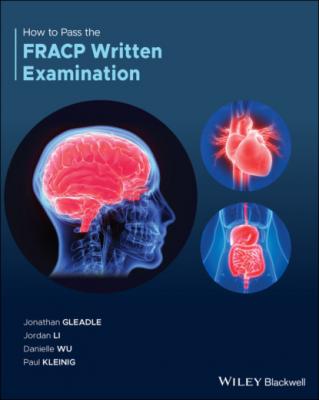How to Pass the FRACP Written Examination. Jonathan Gleadle
Читать онлайн.| Название | How to Pass the FRACP Written Examination |
|---|---|
| Автор произведения | Jonathan Gleadle |
| Жанр | Медицина |
| Серия | |
| Издательство | Медицина |
| Год выпуска | 0 |
| isbn | 9781119599548 |
Hypoglycaemia, severe thrombocytopenia, or encephalopathy.
Any alteration of consciousness (GCS <15) not associated with concomitant sedative overdoses.
Chiew A, Reith D, Pomerleau A, Wong A, Isoardi K, Soderstrom J et al. Updated guidelines for the management of paracetamol poisoning in Australia and New Zealand. Medical Journal of Australia. 2019;212(4):175–183.
https://onlinelibrary.wiley.com/doi/abs/10.5694/mja2.50428
13. Answer: C
Pulseless electrical activity (PEA), previously known as electromechanical dissociation (EMD) is defined as the absence of a palpable pulse in an unconscious patient with organized electrical activity other than VT on ECG. The proportion of PEA among cases of sudden cardiac arrest increases with age. Females are more likely to develop PEA than males. Patients with PEA are more likely to have one or more co‐morbidities than those in the VF/VT group. However, PEA is less likely to occur in those with CCF. In one study, PEA was responsible for 68% of monitored in‐hospital deaths and 10% of all in‐hospital deaths.
PEA more commonly has an underlying cause of the arrest including the Hs and Ts listed below and the most frequent causes are hypoxemia secondary to respiratory failure and hypovolemia due to internal bleeding or a recent haemodialysis. This patient’s PEA is possibly due to hypoxia caused by his infective exacerbation of COPD. Tension pneumothorax also needs to be excluded.
Hs
Hypoxia
Hypovolemia
Hydrogen ion (acidosis)
Hypokalaemia/ hyperkalaemia, hypoglycaemia
Hypothermia
Ts
Toxins
Tamponade (cardiac)
Tension pneumothorax
Thrombosis (massive PE or AMI)
Trauma
The overall prognosis for patients with PEA arrest is dismal unless a rapidly reversible cause is identified and corrected. Only 11% of patients who have PEA as their first documented rhythm survives to hospital discharge. ECG characteristics are related to the patient's prognosis. The more abnormal the ECG characteristics, the less likely the patient is to recover from PEA; patients with a wider QRS (>0.2 sec) have worse prognosis.
PEA is treated in the same way as asystole. It is not a shockable rhythm. You should continue with CPR, administer epinephrine and begin to consider possible causes. Epinephrine can be given every 3 to 5 min.
Pulseless Electrical Activity: Background, Etiology, Epidemiology [Internet]. Emedicine.medscape.com. 2019 [cited 17 August 2019]. Available from: https://emedicine.medscape.com/article/161080‐overview
The Australian Resuscitation Council Guidelines [Internet]. Resus.org.au. 2019 [cited 17 August 2019]. Available from: https://resus.org.au/guidelines/
14. Answer: B
Patients with critical illness are at risk of upper gastrointestinal bleeding, a condition that may be associated with increased mortality. Clinically important gastrointestinal bleeding occurs in 3–5% of ICU patients. Until recently guidelines have recommended preventive therapy with either histamine H2–receptor antagonists or proton‐pump inhibitors (PPIs) for patients in ICU who are at risk for stress ulceration and bleeding. However, any benefit from PPIs might be reduced by harmful events that are associated with the use of these agents, including nosocomial pneumonia, Clostridium difficile enteritis, and myocardial ischemia. The use of enteral feeding may also reduce the risk of gastrointestinal bleeding.
In a recent large trial, patients were randomly assigned to daily intravenous pantoprazole (40 mg) or placebo during their ICU admission. The patients were at high risk for gastrointestinal bleeding because of a history of liver disease, coagulopathy, shock, treatment with anticoagulant agents, renal replacement therapy, or mechanical ventilation that was expected to last for more than 24 hours. There was no significant difference between the groups in the rate of the primary outcome of death nor gastrointestinal bleeding, pneumonia, C. difficile infection, or myocardial ischemia. A further study of use with PPIs vs histamine H2–receptor antagonists for stress ulcer prophylaxis among adults requiring mechanical ventilation did not result in a statistically significant difference for in‐hospital mortality.
Barkun A, Bardou M. Proton‐Pump Inhibitor Prophylaxis in the ICU — Benefits Worth the Risks? New England Journal of Medicine. 2018;379(23):2263–2264.
https://www.nejm.org/doi/full/10.1056/NEJMe1810021
15. Answer: D
AKI is a frequent complication associated with septic shock in patients who require ICU admission. AKI is also associated with an increased mortality rate in these patients.
In a large, multicenter, RCT, patients with early‐stage septic shock with severe AKI based on the failure stage of the risk, injury, failure, loss, and end‐stage kidney disease (RIFLE) system but without life‐threatening complications of AKI were randomised to either receive dialysis within 12 hours after documentation of AKI (early dialysis) or 48 hours after the AKI if no renal recovery was observed (delayed dialysis).
The failure stage of the RIFLE classification system is characterised by a serum creatinine level 3 times the baseline level (or ≥4 mg/dL with a rapid increase of ≥0.5 mg/dL), urine output less than 0.3 ml per kilogram of body weight per hour for 24 hours or longer, or anuria for at least 12 hours.
The trial was stopped early for futility after the second planned interim analysis showed no significant difference in overall mortality at 90 days in the early dialysis vs. delayed dialysis groups.
Barbar S, Clere‐Jehl R, Bourredjem A, Hernu R, Montini F, Bruyère R et al. Timing of Renal‐Replacement Therapy in Patients with Acute Kidney Injury and Sepsis. New England Journal of Medicine. 2018;379(15):1431–1442.
https://www.ncbi.nlm.nih.gov/pubmed/30304656
16. Answer: C
This patient is in septic shock, likely of urinary origin. Sepsis and septic shock are medical emergencies and treatment and resuscitation should begin immediately. Latest guidelines dictate that following initial fluid resuscitation, administration of additional fluids should be guided by frequent assessment of haemodynamic status. This includes thorough clinical examination including blood pressure, heart rate, respiratory rate, temperature, oxygen saturation and urine output.
Previous resuscitation
